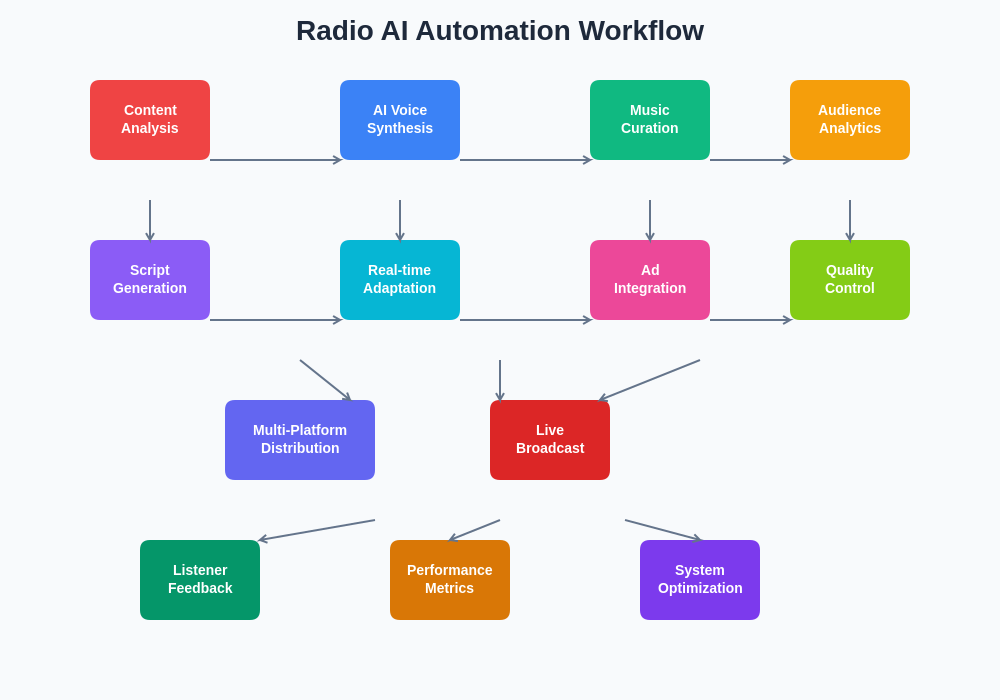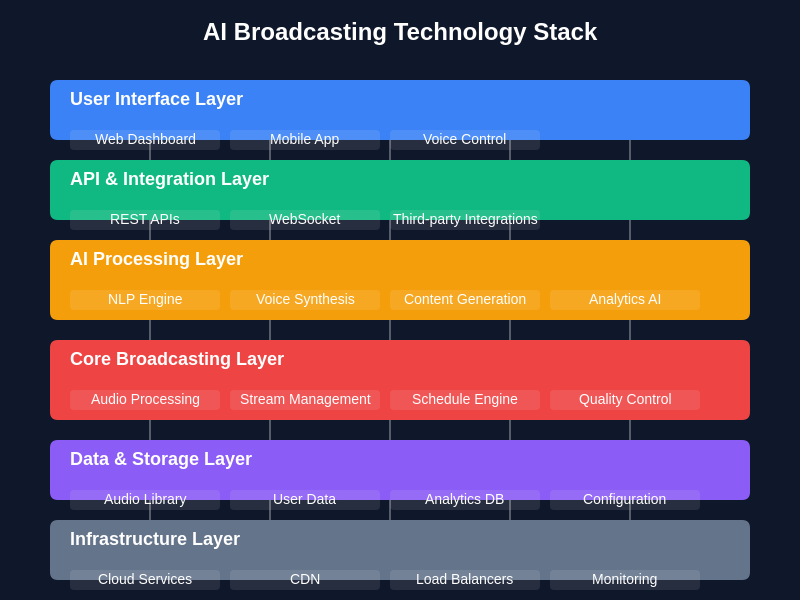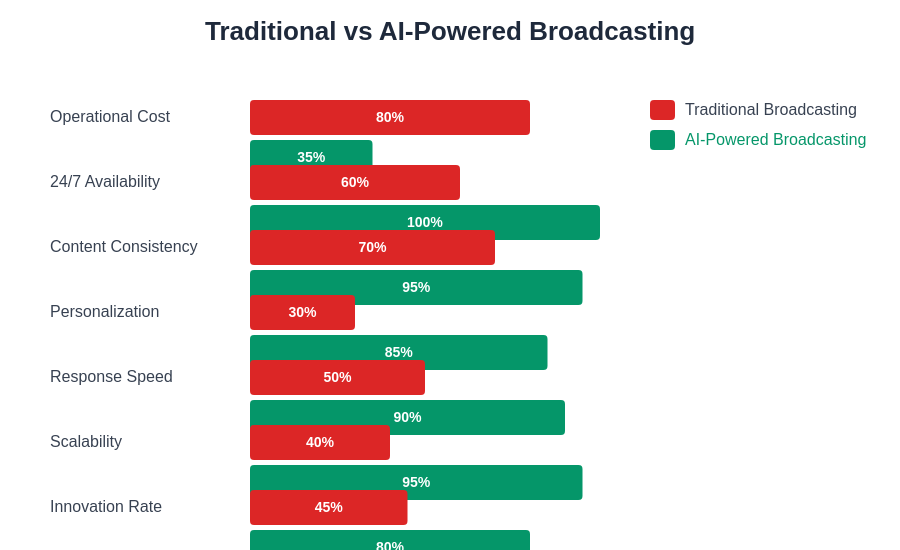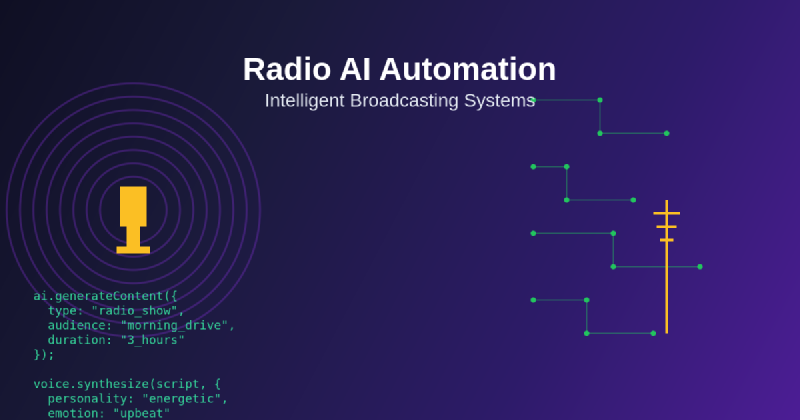The radio broadcasting industry stands at the precipice of a technological revolution that promises to fundamentally transform how audio content is created, curated, and delivered to audiences worldwide. Artificial intelligence has emerged as the driving force behind this transformation, introducing sophisticated automation systems that can generate content, synthesize natural-sounding voices, and intelligently manage programming schedules with unprecedented precision and efficiency. This evolution represents more than just technological advancement; it signifies a complete reimagining of radio broadcasting that combines human creativity with machine intelligence to create more engaging, personalized, and cost-effective broadcasting solutions.
Explore the latest AI innovations in media to understand how artificial intelligence is reshaping entertainment and broadcasting industries across multiple platforms. The integration of AI into radio broadcasting represents a convergence of traditional media expertise with cutting-edge technology, creating opportunities for enhanced listener engagement and operational efficiency that were previously unimaginable.
The Foundation of Intelligent Broadcasting
The traditional radio broadcasting model has relied heavily on human presenters, manual content curation, and predetermined programming schedules that offer limited flexibility and personalization. Modern AI-powered broadcasting systems have revolutionized this approach by introducing intelligent automation that can adapt to real-time audience preferences, generate contextually relevant content, and maintain consistent programming quality throughout the broadcast day. These systems leverage advanced machine learning algorithms, natural language processing, and sophisticated audio synthesis technologies to create seamless broadcasting experiences that rival or exceed traditional human-hosted programming.
The transformation extends beyond simple automation to encompass intelligent decision-making capabilities that can analyze listener behavior patterns, demographic data, and engagement metrics to optimize content selection and presentation timing. This data-driven approach enables radio stations to deliver more targeted programming that resonates with specific audience segments while maintaining the spontaneity and personality that listeners expect from quality radio content.
Advanced Voice Synthesis and AI Presenters
One of the most remarkable developments in radio AI automation is the emergence of sophisticated voice synthesis technology that can create incredibly natural-sounding AI presenters capable of delivering content with human-like intonation, emotion, and personality. These AI voices are no longer the robotic, monotone outputs of earlier text-to-speech systems; instead, they represent sophisticated neural networks trained on vast datasets of human speech patterns, enabling them to convey warmth, humor, excitement, and other emotional nuances that make radio programming engaging and relatable.
Modern AI presenters can be programmed with distinct personalities, speech patterns, and presentation styles that align with specific station brands or target demographics. They can seamlessly transition between different content types, from news updates and weather reports to music introductions and commercial breaks, maintaining consistent quality and engagement throughout their presentations. The technology has advanced to the point where many listeners cannot distinguish between AI-generated voices and human presenters, opening new possibilities for 24/7 programming without the constraints of human scheduling limitations.
Discover advanced AI voice technologies with Claude to explore how sophisticated language models can enhance audio content creation and natural conversation generation. The combination of advanced natural language processing with high-quality voice synthesis creates opportunities for more interactive and responsive broadcasting experiences.
Intelligent Content Generation and Curation
The content creation capabilities of modern radio AI systems extend far beyond simple playlist management to encompass comprehensive content generation that includes news summaries, weather updates, traffic reports, entertainment segments, and even original commentary on current events. These systems can analyze multiple data sources simultaneously, including news feeds, social media trends, local event calendars, and audience engagement metrics, to create relevant and timely content that maintains listener interest and provides genuine value.
AI-powered content curation systems can understand the subtle relationships between different types of content, ensuring smooth transitions between songs, maintaining appropriate energy levels throughout different time periods, and adapting programming to match listener preferences and behavioral patterns. The technology can automatically adjust content selection based on factors such as time of day, day of the week, seasonal considerations, local events, and real-time audience feedback, creating a dynamic programming experience that feels both personalized and professionally curated.
Real-Time Audience Analytics and Adaptation
Modern intelligent broadcasting systems incorporate sophisticated analytics capabilities that continuously monitor audience engagement, listening patterns, and demographic distributions to optimize programming decisions in real-time. These systems can track metrics such as listener retention rates, skip frequencies, volume adjustments, and interactive responses to gauge content effectiveness and make immediate adjustments to improve engagement and satisfaction.
The adaptive nature of AI broadcasting systems enables them to respond to sudden changes in listener behavior, trending topics, or external events by automatically adjusting content selection, presentation style, or programming focus. This responsiveness ensures that radio programming remains relevant and engaging even as circumstances change throughout the broadcast day, providing a level of agility that traditional broadcasting approaches cannot match.
Automated Music Programming and Discovery
The music selection and programming capabilities of AI broadcasting systems represent a significant advancement over traditional playlist management approaches. These systems can analyze vast music libraries to identify optimal song sequences that maintain listener engagement while introducing new artists and genres that align with audience preferences. The technology considers factors such as tempo, key, mood, genre relationships, artist popularity, and historical listener responses to create seamless musical experiences that feel both familiar and surprising.
AI music programming systems can also identify emerging trends and underground artists that align with station demographics, providing opportunities for music discovery that can differentiate radio stations from streaming services and other audio entertainment options. The ability to balance familiar favorites with carefully selected new content helps maintain listener loyalty while expanding musical horizons and supporting artist development.

The comprehensive workflow of modern radio AI automation encompasses multiple integrated systems working in harmony to deliver seamless broadcasting experiences. From initial content analysis and curation through real-time audience monitoring and adaptive programming adjustments, these systems create a sophisticated ecosystem that optimizes every aspect of radio broadcasting.
Dynamic Advertising and Sponsorship Integration
Intelligent broadcasting systems have revolutionized advertising and sponsorship integration by enabling dynamic, contextually relevant ad placement that enhances rather than interrupts the listening experience. AI systems can analyze listener demographics, engagement patterns, and content preferences to select and customize advertisements that align with audience interests and current programming themes. This targeted approach improves advertising effectiveness while reducing listener fatigue and maintaining programming flow.
The technology enables real-time advertising optimization that can adjust commercial content based on factors such as time of day, audience composition, local events, and even weather conditions. Dynamic pricing models and automated sponsor matching systems allow radio stations to maximize advertising revenue while providing sponsors with more effective audience targeting and engagement measurement capabilities.
Enhance your media analytics with Perplexity for comprehensive audience research and market analysis that can inform AI broadcasting strategies and content optimization decisions. The integration of advanced research capabilities with broadcasting automation creates opportunities for more informed programming decisions and strategic content development.
Multi-Platform Integration and Cross-Media Synchronization
Modern radio AI automation extends beyond traditional terrestrial broadcasting to encompass comprehensive multi-platform distribution that includes online streaming, podcast generation, social media integration, and mobile app synchronization. These systems can automatically adapt content formatting and presentation styles for different distribution channels while maintaining consistent branding and messaging across all platforms.
The cross-media synchronization capabilities of intelligent broadcasting systems enable seamless integration with visual content, social media updates, and interactive features that enhance listener engagement and provide additional value beyond traditional audio programming. This multi-platform approach helps radio stations compete more effectively with streaming services and other digital entertainment options while expanding their reach and audience development opportunities.
Personalization and Listener Customization
Advanced AI broadcasting systems offer unprecedented personalization capabilities that can tailor programming content to individual listener preferences while maintaining the communal experience that defines traditional radio broadcasting. These systems can create personalized content streams that adjust music selection, news focus, and presentation style based on listener history and preferences while ensuring that community-relevant content and local information remain accessible to all listeners.
The personalization technology can also enable interactive features that allow listeners to influence programming decisions through voice commands, mobile app interactions, or social media engagement, creating a more participatory broadcasting experience that bridges the gap between traditional radio and on-demand audio content.
Quality Control and Brand Consistency
One of the critical advantages of AI broadcasting automation is the ability to maintain consistent quality and brand adherence throughout all programming content. AI systems can be programmed with specific brand guidelines, tone requirements, and content standards that ensure all generated content aligns with station identity and audience expectations. This consistency is particularly valuable for maintaining professional standards during overnight hours, holiday periods, or other times when human oversight may be limited.
The quality control capabilities of intelligent broadcasting systems extend to real-time monitoring of audio quality, content appropriateness, and regulatory compliance, providing automated safeguards that protect station reputation and ensure adherence to broadcasting standards and regulations.

The modern radio AI technology stack represents a complex integration of multiple specialized systems working together to deliver comprehensive broadcasting automation. From low-level audio processing and voice synthesis through high-level content strategy and audience analytics, each component contributes to the overall intelligent broadcasting capability.
Cost Efficiency and Operational Optimization
The implementation of intelligent broadcasting systems offers significant cost advantages through reduced staffing requirements, improved operational efficiency, and enhanced content production capabilities. AI automation can handle routine programming tasks, content generation, and audience monitoring that would otherwise require multiple human staff members, allowing radio stations to allocate human resources to higher-value activities such as community engagement, special event programming, and strategic content development.
The operational optimization benefits extend beyond direct cost savings to include improved scheduling flexibility, reduced human error rates, and enhanced ability to respond to changing market conditions or audience preferences. These efficiency gains enable radio stations to maintain competitive programming quality while operating with leaner budgets and more flexible staffing arrangements.
Technical Infrastructure and Implementation Considerations
The successful deployment of intelligent broadcasting systems requires careful consideration of technical infrastructure requirements, including high-performance computing resources, reliable internet connectivity, redundant backup systems, and integration with existing broadcasting equipment. Modern AI broadcasting platforms are designed to integrate seamlessly with traditional radio infrastructure while providing cloud-based scalability and remote management capabilities that support both large broadcasting networks and independent stations.
Implementation considerations include staff training requirements, content migration procedures, regulatory compliance verification, and gradual transition planning that ensures continuity of service while new systems are deployed and optimized. The modular nature of modern AI broadcasting platforms allows for phased implementation that can be tailored to specific station requirements and budget constraints.
Regulatory Compliance and Industry Standards
The integration of AI automation into radio broadcasting must comply with various regulatory requirements and industry standards related to content appropriateness, advertising disclosure, emergency broadcasting capabilities, and accessibility provisions. Intelligent broadcasting systems incorporate automated compliance monitoring and reporting capabilities that help stations maintain adherence to regulatory requirements while providing documentation and audit trails for regulatory review.
The technology also supports enhanced accessibility features such as automated closed captioning generation, audio description capabilities, and multilingual content adaptation that can help radio stations better serve diverse audience needs and comply with accessibility regulations.

The transformation from traditional broadcasting methods to AI-powered intelligent systems demonstrates significant improvements across multiple operational and performance metrics. These enhancements include increased operational efficiency, improved content quality consistency, enhanced audience engagement, and reduced operational costs while maintaining or improving programming quality.
Future Developments and Industry Evolution
The future of radio AI automation promises even more sophisticated capabilities, including advanced emotional intelligence that can detect and respond to audience mood changes, predictive analytics that can anticipate content preferences before they become apparent in listener behavior, and seamless integration with emerging technologies such as virtual reality and augmented reality audio experiences.
Emerging developments in AI technology will likely enable more natural conversational interactions between AI presenters and listeners, more sophisticated content generation capabilities that can create original music and audio content, and enhanced integration with smart home devices and automotive systems that expand the reach and accessibility of radio programming.
The evolution of intelligent broadcasting systems will continue to blur the lines between traditional radio programming and personalized audio experiences while maintaining the community connection and local relevance that distinguish radio from other audio entertainment options. This evolution represents an opportunity for radio stations to enhance their value proposition and competitive position in an increasingly crowded audio entertainment marketplace.
Implementation Best Practices and Strategic Considerations
Successful implementation of radio AI automation requires careful planning that balances technological capabilities with audience expectations, brand identity, and operational requirements. Best practices include gradual implementation that allows for audience adaptation, transparent communication about AI integration that maintains listener trust, and strategic content planning that leverages AI capabilities while preserving human creativity and local community connection.
Strategic considerations include competitive positioning, audience development opportunities, revenue optimization potential, and long-term technology evolution planning that ensures AI broadcasting investments remain viable and effective as technology continues to advance. The most successful implementations combine AI automation capabilities with human expertise and creativity to create broadcasting experiences that exceed what either approach could achieve independently.
The transformation of radio broadcasting through artificial intelligence represents a fundamental shift that offers tremendous opportunities for enhanced efficiency, improved audience engagement, and innovative programming approaches. As this technology continues to evolve, radio stations that embrace intelligent automation while maintaining their unique brand identity and community connection will be best positioned to thrive in the evolving audio entertainment landscape.
Disclaimer
This article is for informational purposes only and does not constitute professional advice regarding broadcasting technology implementation or industry strategy. The views expressed are based on current understanding of AI broadcasting technologies and industry trends. Readers should conduct thorough research and consult with broadcasting technology experts when considering AI automation implementation. The effectiveness and suitability of AI broadcasting systems may vary depending on specific station requirements, audience characteristics, and regulatory environments.
